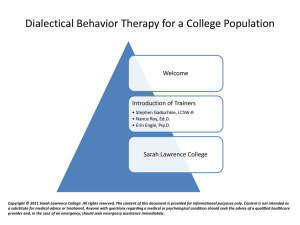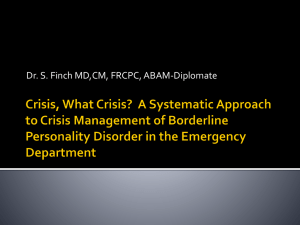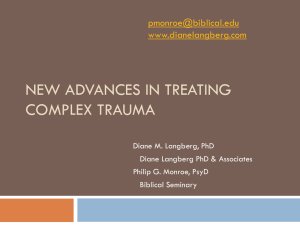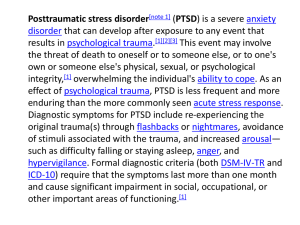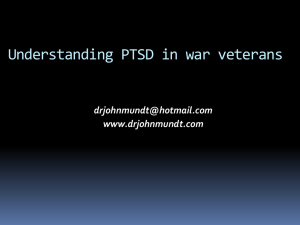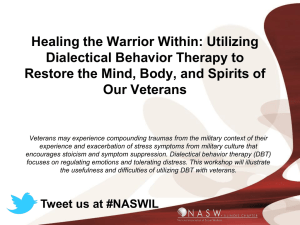Research Update - Borderline Personality Disorder
advertisement
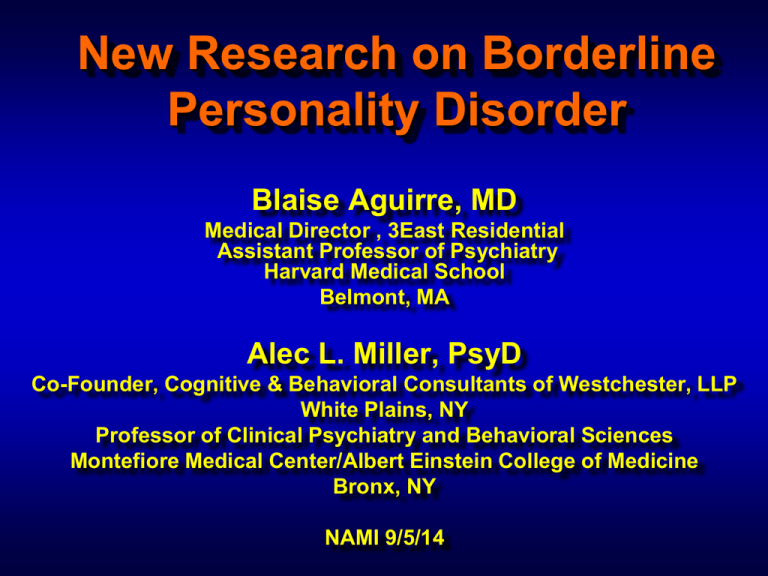
New Research on Borderline Personality Disorder Blaise Aguirre, MD Medical Director , 3East Residential Assistant Professor of Psychiatry Harvard Medical School Belmont, MA Alec L. Miller, PsyD Co-Founder, Cognitive & Behavioral Consultants of Westchester, LLP White Plains, NY Professor of Clinical Psychiatry and Behavioral Sciences Montefiore Medical Center/Albert Einstein College of Medicine Bronx, NY NAMI 9/5/14 Outline • BPD diagnosis, prevalence, and self-harm – The 5 problem areas • Existing evidence-based BPD treatments • DBT research • • • • – First adolescent RCT Early Intervention Prevention BPD and Trauma research Future Directions Borderline Personality Disorder (Re-organized in DBT) Emotion Dysregulation Affective lability Problems with anger Interpersonal Dysregulation Chaotic relationships Fears of abandonment Self Dysregulation Identity disturbance/ difficulties with sense of self Sense of emptiness Behavioral Dysregulation Parasuicidal behavior Impulsive behavior Cognitive Dysregulation Dissociative responses/ paranoid ideation BPD in ADULTS DSM-IV and epi studies find BPD in: 1.8% of the general population, 8 to 11% of psychiatric outpatients, and 14 to 20% of inpatients. **NIAAA Study of 34,653 adults found: Prevalence of lifetime BPD was 5.9%, with no significant difference between gender (J of Clin Psychiatry, 2008) 4 BPD is associated with fatal and non-fatal suicidal behaviors as well as nonsuicidal selfinjurious behaviors 6 BPD Can Be Fatal • Among SUICIDES, –40-65% have PD • Among PDs, –BPD is most associated with suicidal behavior • Among BPD, –8-10% commit suicide –up to 75% attempt suicide –69-80% self-mutilate 7 ESTs for BPD: Mentalization (Bateman & Fonagy) •AJP, 1999; 2013 •JAACAP, 2012 (Roussow & Fonagy) -ADOLESCENTS Transference-focused (Kernberg, Clarking, Levy et al) •JCCP 2006; AJP, 2007; Archives, 2006; BJP, 2010 Schema-focused (Young et al.) •Archives, 2006; 2009 STEPPS (Blum et al.) • 2008; 2010 Cognitive Analytic Therapy (Chanen et al.) • BJP, 2008; 2012 DBT (Linehan et al.) •Archives, 1991, 1993, 1998, 1999, 2006, etc, >18 RCTs •JAACAP, in press (Mehlum et al.)-ADOLESCENTS 8 9 18 Randomized Clinical Trials DBT Superior to Comparison Treatments Reducing: • • • • • • Suicide attempts and self-injury Premature drop-out Inpatient/ER admissions and days Drug abuse Depression, hopelessness, anger Impulsiveness Increasing: • Global adjustment • Social adjustment See Lieb, K., Zanarini, M., Linehan, M., & Bohus, M., 2004. 9 10 to severe and chronic multi-diagnostic, difficult-to-treat patient with both Axis I and Axis II disorders 10 11 The Problem FOCUS ON CHANGE !!AROUSAL!! SENSE OF INVALIDATION OUT-OF-CONTROL OF SELF-CONSTRUCTS Impaired Cognitive Processing + Intense Effort to Control No New Learning – No Collaboration 11 12 The Problem Further FOCUS ON ACCEPTANCE !!AROUSAL!! SENSE OF INVALIDATION OF SUFFERING OUT-OF-CONTROL No New Learning – No Collaboration 12 13 Solution Was to Apply A Approach Balancing Change Strategies Acceptance Strategies Dialectics 13 Problem Areas Skills 1. Confusion about Self 1. Mindfulness 2. Impulsivity 2. Distress Tolerance 3. Emotional Instability 3. Emotion Regulation 4. Interpersonal Problems 4. Interpersonal Effectiveness 5. Adolescent - Family Dilemmas 5. Walking the Middle Path Adolescent Outpatient DBT Modes • • • • • • • • • Phase I: 4-6 months Multi-family skills training group Individual psychotherapy Telephone consultation (w/ teen & parent) Family therapy Therapist consultation meeting Phase II: 16 weeks & recommit Graduate group Individual psychotherapy (phase out) Telephone consultation Family therapy, PRN *All patients are eligible for pharmacotherapy Dialectical Behavior Therapy for Adolescents with Recent and Repeated Suicidal and Self harm Behavior - a Randomized Controlled Trial Mehlum, L, Tormoen, A, Ramberg, M, Haga, E, Diep, L, Laberg, S, Larsson, B, Stanley, B, Miller, AL, Sund, A, Groholt, B. (In press, Journal of the American Academy of Child and Adolescent Psychiatry). L.Mehlum 2012 Overall aim To determine the efficacy of DBT-A compared to enhanced usual care in adolescents with recent and repetitive self harm and with three or more borderline personality disorder criteria. L.Mehlum 2012 Design • Randomized Controlled Trial with independent and blinded pre-, post and follow-up evaluations • Measurements at: – – – – – – Baseline (interview, self-report and testing) 6 weeks (self-report) 12 weeks (self-report) 16 weeks - End of treatment (interview, self-report and testing) 1 year posttreatment follow-up (interview, self-report and testing) 2 years posttreatment follow-up (interview, self-report and testing) • Ten year follow-up planned L.Mehlum 2012 Treatment methods 1. DBT – Adapted for adolescents – 16 weeks 2. Enhanced Usual Care (EUC) – 16 weeks Psychodynamic or CBT oriented therapy (non-DBT) Treatments were delivered at five Child and Adolescent Outpatient Clinics in Oslo, Norway L.Mehlum 2012 Adolescent Outpatient DBT Modes Phase I: 4 months (RESEARCH STUDY) • Multi-family skills training group • Individual psychotherapy • Telephone consultation (w/ teen & parent) • Family therapy • Therapist consultation meeting Phase II: 16 weeks & recommit (NOT RESEARCH) • Graduate group • Individual psychotherapy (phase out) • Telephone consultation • Family therapy, PRN *All patients are eligible for pharmacotherapy DBT therapists • Recruited from five Child & Adolescent outpatient psychiatric clinics at the Oslo University Hospital • MDs and Psychologists • All therapists were new to DBT and trained for the purpose of the trial and hired if/when reaching a consistently high adherence level (score >= 4.0 on Linehan adherence coding instrument) • Trained for the purpose of the trial in suicide risk assessment and management • All treaments were conducted at and paid for by the Oslo University Hospital Coding of 166 individual therapy sessions Mean score = 4.11 SD = 0.14 L.Mehlum 2012 Participants • Patient inclusion: March 2008 thru March 2012 • Altogether 77 patients were included and randomly allocated to receive: – DBT-A (n=39) – or – EUC (n=38) • Stratified by gender, presence of major depression and suicide intent at most severe self-harm episode last 4 months before enrollment. L.Mehlum 2012 RCT of DBT-A vs EUC for self-harming and suicidal adolescents with emotion dysregulation (N=77) Patient characteristics - baseline Dialectical Behaviour Therapy N=39 Enhanced Usual Care N=38 N % N % Girls (%) 34 87.2 34 89.5 Completed high school 13 41.9 7 25.0 Parents currently married 17 43.6 17 44.7 Mean SD Mean SD Age (yrs) 15.9 1.4 15.3 1.6 C-GAS 55.3 8.0 57.9 10.1 No significant differences between groups L.Mehlum 2012 RCT of DBT-A vs EUC for self-harming and suicidal adolescents with emotion dysregulation (N=77) Patient characteristics – baseline cont. Dialectical Behaviour Therapy N=39 Enhanced Usual Care N=38 N % N % Psychiatric treatment (past) 28 73.7 23 62.2 Pharmacotherapy (past) 2 5.4 6 17.1 Child protection (past) 10 26.3 11 28.9 Child protection (current) 6 15.4 7 18.4 Mean SD/SE Mean SD/SE CBCL (total no of problems) 69.6 11.0 68.4 8.6 Lifetime NSSH episodes (mean/rate) 29.8 2.8 25.9 3.0 Lifetime suicide attempts (mean/rate) 3.2 0.6 3.1 0.6 No significant differences between groups L.Mehlum 2012 So what about the outcomes? L.Mehlum 2012 Conclusions • Patients receiving DBT-A experienced significant reductions in all 3 primary outcome measures, in contrast to patients receiving EUC where only self-reported depression was significantly reduced • Patients who received DBT-A had a significantly – – – – – Stronger reduction in the number of self-harm episodes Stronger decline in suicidal ideation Stronger reduction in interviewer rated depressive symptoms Stronger reduction in hopelessness feelings Stronger reduction in borderline symptoms L.Mehlum 2012 Next steps in Norway • 1 year posttreatment follow-up (interview, self-report and testing) - ongoing • 2 years posttreatment follow-up (interview, self-report and testing) – ongoing • 10 year posttreatment follow-up – planned • Evaluate effectiveness of Adolescent DBT Graduate Group as a maintenance, continuation phase of treatment L.Mehlum 2012 Prevention & Early Intervention DBT in School Settings • Secondary and Tertiary Prevention: – Middle and HS – Elementary schools • Primary Prevention Interventions – Elementary schools 30 • DBT in Schools School Interventions – Ulster County HS Health Class Curriculum (1999) – Far Rockaway HS • Salley et al, (2002) – New Haven Elementary School/Yale University • Perepletchikova et al, (2010) – PS 8 Bronx, NY/Albert Einstein College of Medicine • Lander, Miller, Edwards, et al, (2009-2012) – Ardsley School District, NY (2008-present) • School-based Mental Health Teams in MS and HS and • Now teaching in Health Class • Presented data at conferences (Catucci et al.; Mason et al) – Pleasantville, NY School District (2009-present) • School-based Mental Health Teams in MS and HS – Mamaroneck, NY School District (2010-present) – Rockland County BOCES HS (2012-present) – New Rochelle and Florida, NY School Districts (2012-present) – University of Washington, MS & HS Education • Mazza & Mazza (2010-) Do not reproduce or distribute without written permission from CBC. © CBC 2012 Dialectical Behavior Therapy in Public Schools STEPS-A (Emotional Problem Solving for Adolescents; Mazza et al, in preparation) is a Universal program – Teacher administered 42-minute/class DBT curriculum 5-10% Using an RTI model 10-15% 80-85% Tier III Indicated Using Mental Health model Tier II Selected Population Tier I Universal Population (Mazza, 2012) Why DBT in Schools? • Mounting pressure to keep ED (emotionally disabled) students within District – Costs District @ 100K/per student per year when sent out of District for specialized programs. Do not reproduce or distribute without written permission from CBC. © CBC 2012 32 Why DBT in Schools? • Schools often urge staff to send students to ER when suicidal thinking or self-harm is reported. • ERs are flooded with visits from students who do not necessarily need hospitalization. • Sending students to ER may reinforce problem (escape/avoidance) behaviors. Do not reproduce or distribute without written permission from CBC. © CBC 2012 33 Data from Schools • Preliminary results from an open trial at Ardsley High School (Mason, Catucci, Lusk, and Johnson, 2011) – Reduced referrals to assistant principal – Reduced cutting class – Reduced detentions and suspensions – Anecdotal reduction in depression, anxiety, NSSI – Requires change of culture re: how schools manage problem behavior Do not reproduce or distribute without written permission from CBC. © CBC 2013 34 Why DBT in schools? • It may be more cost-effective • It may reduces problem behaviors that often result in suspensions, ER visits, etc • DBT is skills based, can be taught in groups/classes • It can be applied transdiagnostically • DBT has observable and measurable outcomes • It may PREVENT BPD symptoms? Do not reproduce or distribute without written permission from CBC. © CBC 2013 35 DBT in Schools Reference : Mazza, JJ, Dexter-Mazza, ET, Murphy, HE, Miller, AL, & Rathus, JH (In preparation). Skills Training for Emotional Problem Solving for Adolescents (STEPS-A): Implementing DBT skills training in schools . Guilford Press. Do not reproduce or distribute without written permission from CBC. © CBC 2012 Dalai Lama Early Intervention in BPD Current evidence supports: the development of indicated prevention and early intervention programs for the emerging BPD phenotype (Chanen et al. 2007, 2008) Benefits of Early Intervention are likely to outweigh risks, such as stigmatizing attitudes from clinicians. (Chanen et al. 2007, 2008) Potential opportunities for Early Intervention is frequently missed Identification of outpatient youth with DSM-IV BPD is feasible through screening (Chanen et al. 2008) The Evidence 15-18 yo (41 to CAT vs. 37 to GCC vs. 32 TAU) ≥ 2 DSM-IV BPD criteria one or more childhood risk factors for young adult generic PD childhood PD symptoms disruptive behavior disorder symptoms low socio-economic status depressive symptoms history of childhood abuse or neglect Assessments Baseline (n=78) 6-months (n=70) 12-months (n=70) 24-months (n=68) At least three time points in 92% of sample Outcome Variables Total BPD score (SCID-II) Youth self-report (YSR; Achenbach, 1991) Internalizing Externalizing Social and occupational functioning (SOFAS) Parasuicidal behaviors suicide attempts and non-suicidal self-injury semi-structured interview coded as: none, monthly, weekly and daily Main Results At 24-month follow-up: CAT and GCC was more effective than TAU CAT yielded the greatest median improvement on the four continuous measures CAT had lower levels of and a faster rate of improvement in externalizing, compared to GCC* CAT had lower levels of and a significantly faster rate of improvement in both internalising and externalising, compared to TAU GCC had lower levels of internalising and a faster rate of improvement in SOFAS, compared to TAU All treatment groups demonstrated significant and clinically substantial improvement. Conclusions Early intervention for BPD is possible Patients 13-15 years younger than in recent RCTs GCC not ineffective perhaps easier to teach Need longer-term follow-up gains sustained? divert patients from unhelpful engagement with adult treatment settings? Childhood Trauma and Adolescent Borderline Personality Disorder Co-morbidity: Clinical and Treatment Implications Blaise Aguirre, MD Medical Director 3East Residential Assistant Professor of Psychiatry Harvard Medical School BPD, PTSD and Childhood Maltreatment Prevalence of borderline personality disorder (BPD) comparable or slightly higher in adolescents vs. adults 2+% adulthood (APA, 2000) 3%-6% in adolescence (Zanarini, 2003; Chabrol et al., 2004) In the Adult BPD Population Childhood maltreatment/trauma – as high as 85% (Venta et. al., 2012) Prevalence of PTSD-33%-58% (Harned & Linehan, 2008) Trauma and PTSD increases the likelihood of remission from BPD (Zanarini et. al., 2005) In the Adolescent BPD Population Only a few studies have explored the link between BPD and trauma in adolescents Childhood sexual abuse successfully discriminated between patients with BPD and MDD Co-occurrence of Borderline Personality Disorder (BPD),Trauma and Post-Traumatic Stress Disorder (PTSD) BPD inpatients have rates of PTSD from 56-58%; BPD outpatients have rates of PTSD from 36-50%1 Epidemiologic research has indicated that 30.2% of individuals with BPD have PTSD, whereas 24.2% of individuals with PTSD have BPD2 Childhood abuse in BPD pop. found to be from 61% to 76%3 BPD clients experience adult traumas at a higher rate than non-BPD peers with rates as high as 90%4 Co-occurring PTSD is associated with greater impairment in individuals with BPD and lower likelihood of long-term remittance of BPD5 BPD clients with PTSD engage in more frequent NSSI than those without PTSD6 1 Zanarini 4Zanarini 2Pagura 5Harnad et. al., 1998, 2004;Linehan et. al., 2006 et. al., 2010 3Zanarini et. al., 1997, 2006 et. al., 2005 et. al., 2010; Zanarini et. al., 2006 6 (Rusch et al., 2007) Our Research Data Female adolescents (n = 157) Ages 13-20 (Mean age = 17.21; SD= 2.39) Short-Term Residential Program Length of Stay (Mean = 72days) Pre- and Post-Treatment Assessments BPD Criterion and Symptoms PTSD Symptoms Depressive Symptoms Childhood Maltreatment Risky Behavior Engagement Results Relationship of Trauma to Initial BPD Criterion Behaviors Adolescents with moderate-severe trauma report higher initial levels of borderline psychopathology (t=-2.47, p=.02) Robust association between childhood emotional/sexual trauma and severity of borderline psychopathology as measured by ZAN-B (r=.18, p=.05) and MSI (r=.28, p=.002) Adolescents with trauma history also report greater risky behavior engagement as measured by Total RBQ scores which were highly correlated with both physical (r=.23, p=.01) and sexual abuse (r=.19, p=.03) Impact of Trauma in Adolescence Childhood Sexual Abuse (CSA) is a strong predictor of substance abuse, conduct disorder and depression1 Up to 20% of all adolescent suicide attempts are attributable to CSA; CSA victims are 8X more likely than non-abused counterparts to attempt suicide repeatedly in adolescence2 Adolescents with sexual-abuse-related PTSD also have more high-risk sexual behaviors as adolescents3 Trauma survivors with PTSD are more likely to report health problems than those without PTSD4 (Schnurr & Green 2004) making it a public health problem. 1 2 3 Stiffman, Diamond et. al., 2001 Brown et. al, 1999 4 Schnurr & Green 2004 1992 Initial Level of Borderline Symptoms as a Function of Trauma Risky Behavior by Trauma History With Standard (DBT) Although showing decreases in PTSD over time, a significant proportion (56.7%) of patients with histories of childhood abuse still met clinical criteria for PTSD on the CPSS at the time of program discharge Patients with a history of childhood abuse/maltreatment showed relatively less change in PTSD scores then their non-abused counterparts Many of our patients with trauma histories reported using BPD criterion behaviors as way to manage their PTSD symptoms and traumatic memories Overall this data suggests that childhood trauma may play a pivotal role in the genesis of BPD and increase the intractability of PTSD Effectiveness of Standard DBT for BPD+PTSD 1 DBT is the most empirically supported treatment available for SI and NSSI, particularly among individuals with BPD1,2 In recent study of DBT for suicidal BPD women, however, only 13% of clients with co-occurring PTSD achieved full remission after one year3 DBT alone has not been shown to help achieve remission of PTSD as an Axis-I diagnosis, either with or without SI/SB/NSSI4,5 Harnad, Comtois and Linehan, 2010 2 Harned & Linehan, 2008 3 Harned et. al., 2008 4, (Feigenbam et. al., Chapter, in preparation) 5Harnad-Invited Suicide and Self-Injury in BPD Among inpatients with BPD, 70% have multiple episodes of NSSI and 60% report multiple suicide attempts1 BPD clients with PTSD engage in more NSSI than those without PTSD2 The rate of completed suicide among individuals with BPD is estimated to be 8-10%3 Clients with BPD+PTSD are more likely than those with BPD alone to report a variety of trauma-related cues for self-injury4 Relationship betweenCSA and NSSI may be mediated by the PTSD symptom clusters of re-experiencing and avoidance/numbing5 1 Zanarini et. al., 2008 2 Harned et. al., 2010 3 Linehan et. al., 2000 4 5 Harned, in press Weierich & Nock, 2008 Treatment Dilemmas for the PTSD/BPD Client with SI/NSSI/SA Empirical support is robust for Cognitive Behavioral Therapy (CBT) with Prolonged Exposure (PE) as treatment of choice for both adults and adolescents with PTSD1 Pendulum of treatment swung in the late 90’s to exclusion of individuals with SI, SB or NSSI from established PTSD treatments involving activation of trauma memories2 Current practice guidelines stipulate, "if significant suicidality is present it must be addressed before any other treatment is initiated”1 Left unanswered how to treat adolescents with self-injury, SA, Dissociation and PTSD that is moderate to severe and intractible to other interventions. 1 Foa et. al., 2009 2008 2 Stirman, Current Exclusion Criteria for Prolonged Exposure (PE)Treatment * Imminent threat of SB or Homicidal Behaviors Serious NSSI in past three months Current psychosis High risk of being assaulted from environment Lack of clear/sufficient memory of trauma Substance abuse Severe Dissociation *Foa et. al., 2009 Evidence for DBT as ‘Primer’ Treatment for BPD+PTSD DBT is efficacious in reducing suicidal/NSSI behaviors in clients with BPD/PTSD1 Using this approach for clients with BPD/PTSD, both imminent self-injury and imminent suicide risk decreased over a one year period2 BPD+PTSD clients showed a significant decrease in severe dissociation and substance dependence decreased from pre-to-post treatment2 Among BPD+PTSD clients who became eligible for exposure treatment, the majority (82%) still continued to meet criteria for PTSD Some BPD patients are unable to stop target behaviors until their PTSD is resolved; challenge is to find ways to safely make PTSD treatment available to these clients. 1 Harnad & Linehan, 2008 2 (Harnad et. al., 2010) Integrated Treatment: DBT+DBT/PE Protocol Provides integrated treatment for BPD and PTSD Focus is specifically on BPD + self-injury Uses standard DBT in combination with PE for PTSD Recent evidence shows that treatment is feasible with no worsening of target/safety behaviors or increased drop-out from treatment.1 Remission rates comparable to those found in metaanalysis of exposure treatments to PTSD on singlediagnosis populations. 1 Harnad, 2011 An Integrated DBT /PE Treatment Approach: Further Modifications for Adolescents with BPD+PTSD Dialectical Behavior Therapy Prolonged Exposure Protocol Prolonged Exposure Protocol (Harned et. al., 2012)) Eligible patients completed 2-5 exposures per week Baseline PTSD symptoms Developed an exposure hierarchy focusing on imaginal exposures During exposures Pre and post-exposure SUDS were measured Pre-and-post ratings were done for the primary emotions, urges for self-harm and Radical Acceptance Aims: (a) changes in PTSD symptoms and (b) changes in levels of rated emotions, urges and cognitions Importance of Parental Involvement Parents are key sources of information about patient, trauma history and family functioning Parents/Family should receive education about PTSD and be enlisted to support patient in recovery Issue of patient’s confidentiality/privacy should be directly addressed with both patient and family Use joint meetings to develop contract for ongoing family involvement including detailing specific role in crisis management, homework/hierarchy completion and treatment meetings. Stress the Importance of joint exposure and skill development in instances of family trauma/loss Final Points Trauma is present in many patients with BPD PTSD worsens the prognosis and symptoms expression in BPD PTSD does not remit in a non integrated DBT+PE treatment Data suggests that very suicidal BPD patients with trauma can treated far sooner than we ever imagined! Future Directions for BPD Research • • • • • Early identification Prevention Involving families (e.g,. Family Connections) Treatment NEABPD Think Tank 2014 and beyond

